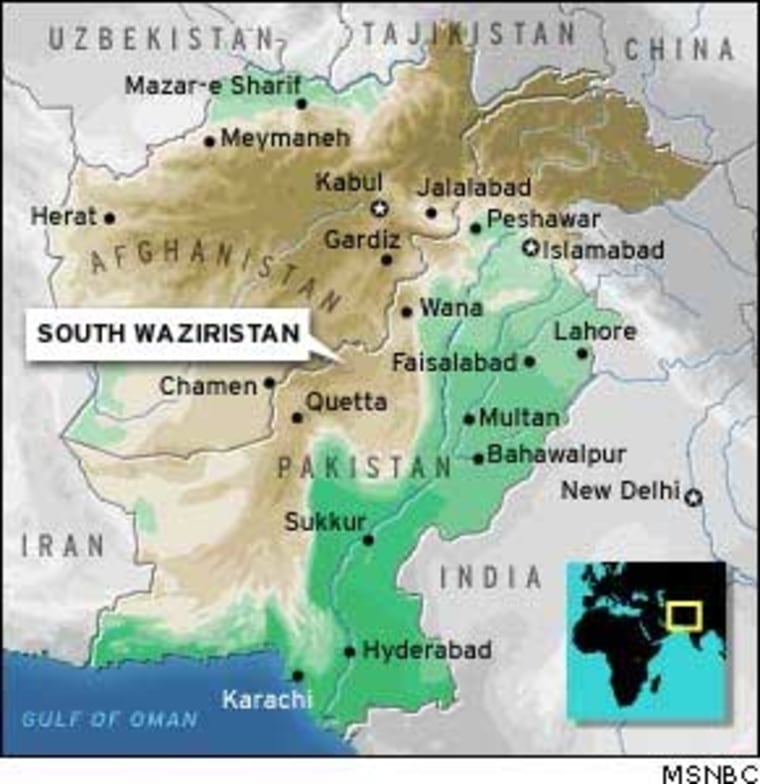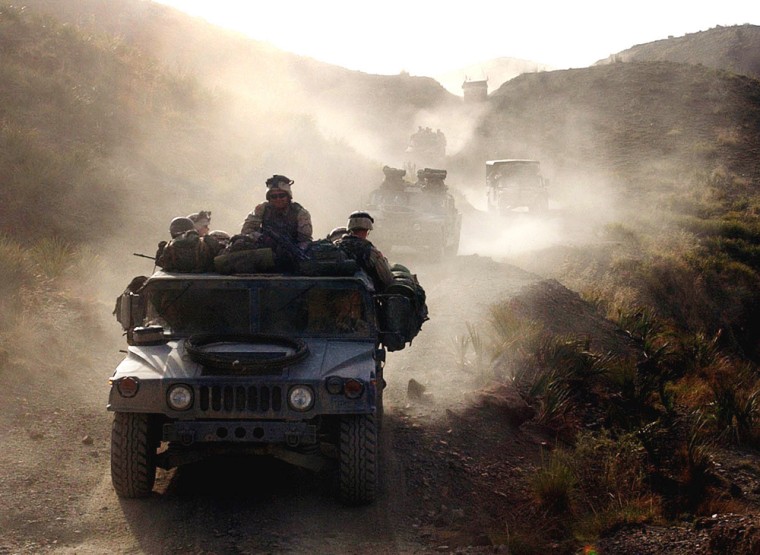Although the United States denies that the strategy has changed, the evidence on the ground in Afghanistan suggests that the hunt for Osama bin Laden and his top aides has taken a new, more serious, turn.
If successful, the strategy could lead the U.S. forces to the holy grail of the war on terrorism, the capture of the so-called high-value targets: Bin Laden and his deputy, Dr. Ayman al-Zawahri.
For the past two weeks, a stream of international reporters and media crews have filled Kabul’s modest Intercontinental Hotel, all trying to read the tea leaves and compare notes on rumors of an imminent, major "spring offensive."
The move, in conjunction with Pakistani forces, would squeeze al-Qaida and Taliban fighters from both sides of the border.
For its part, the U.S. military has been trying hard to douse the media's burning expectations. Gen. David Barno, who commands U.S.-led coalition forces here, publicly backed off from his earlier prediction that bin Laden would be caught this year.
At a briefing with reporters on Friday, he suggested that current operations along the border, part of Operation Mountain Storm, now in its sixth week, was low-key and that the number of combat encounters had actually dropped off.
Quelling rumors
That analysis was echoed this week by the new brass in town. Gen. Eric Olson, the commander of the 25th Infantry Division, will manage all future combat operations as the fresh 25th ID replaces the famed 10th Mountain Division.
“Right now I don’t see any major offensive,’’ Olsen told a group of reporters at Bagram Airbase, north of Kabul, during a recent transfer-of-authority ceremony.
“What I see is combat operations continuing at the present level with, I hope, an expansion of support and reconstruction operations — like building more schools, hospitals and roads.’’
But what about the al-Qaida manhunt?
“We will continue the hunt,’’ Olsen said. "It is a top priority mission for these forces. It is very difficult to predict any timeline, but you will see, over the coming months, additional capabilities, additional resources, devoted to this hunt.’’
Coalition forces at highest level in Afghanistan
In fact, the muscles are beginning to flex: U.S. and coalition forces are at their highest levels in Afghanistan since the war that sent al-Qaida and the Taliban fleeing.

The recent arrival of some 2,500 U.S. Marines, a full Marine Expeditionary Unit, means that more than 16,000 troops could be called on, not only to guard against anticipated violence as the September Afghan national elections approach, but also to help out as the search for bin Laden intensifies.
The current buildup is truly a joint effort.
On the Pakistani side of the border, as many as 100,000 troops — including army soldiers, Ranger commandos and paramilitaries — have been steadily building hundreds of outposts along the 1,500-mile-long spine of rugged ridgelines, looking for al-Qaida fugitives and sympathizers.
Last week, some 6,000 Pakistani troops surrounded the Shawal Valley, a high, forested plateau that straddles the border, a potential hideaway for bin Laden.
Those forces have given a Tuesday deadline to fiercely independent local tribesmen, to hand over any "foreigners" they may be harboring, or face a military assault.
U.S. military officials, who heap praise on Pakistan’s apparent commitment to crack down on al-Qaida, say the strategy is to stir the pot: to get al-Qaida and Taliban fugitives on the move, over the border and into a trap.
“The terrorists are concerned about coming across the border,” Gen. Barno said, “because they know we are going to hammer them when they come across.’’
‘HVT-1 and HVT-2’
But many analysts think bin Laden and al-Zawahri are too clever and war-hardened to be caught in such a trap. That is why the real hunt for high-value targets will go largely unseen by the media, or the public.
The hunt — intelligence-driven and covert — has been in full swing for weeks.
A joint Special Operations commando unit called TF-121, including Delta Force, Navy Seals and the British Special Air Service, has dug helipads and bunkers into a number of mountain perches overlooking north and south Waziristan, the two Pakistani tribal areas where it is believed both bin Laden and al-Zawahri may be hiding.
Meanwhile, CIA operatives and computer analysts, along with U.S. forces and Afghan interpreters, are combing remote villages for contacts and clues while building up a "terrorist database" they believe will eventually lead them to HVT-1 and HVT-2.
The process is very similar to the months of behind-the-scenes, laborious detective work that led to the connections that ultimately opened the door to the spider hole in which Saddam Hussein was hiding.
“There’s always the hunt for Osama bin Laden,’’ explained Gen. Richard Myers, the chairman of the Joint Chiefs, during a surprise visit to Kabul on Friday. “We have folks who spend a lot of time worrying about where he is, where al-Zawahri is, where the top leadership in al-Qaida is.’’
Reports indicate that TF-121 is now spread out in several mountain camps, including in at least three border areas of particular interest, ready to move on a moment’s notice when the call comes.
Also, U.S. military officials confirm that more intelligence-gathering assets are on their way, probably including additional Predator drones armed with Hellfire missiles, to track and take out any positively identified target.
In this secret offensive, no one in the know is willing to talk about tactics or operations — not even a hint of a time frame.
Yet sifting through those tea leaves, U.S. forces seem more focused and determined to get the world’s most wanted men than at any time in the already 2½-year-long manhunt.
